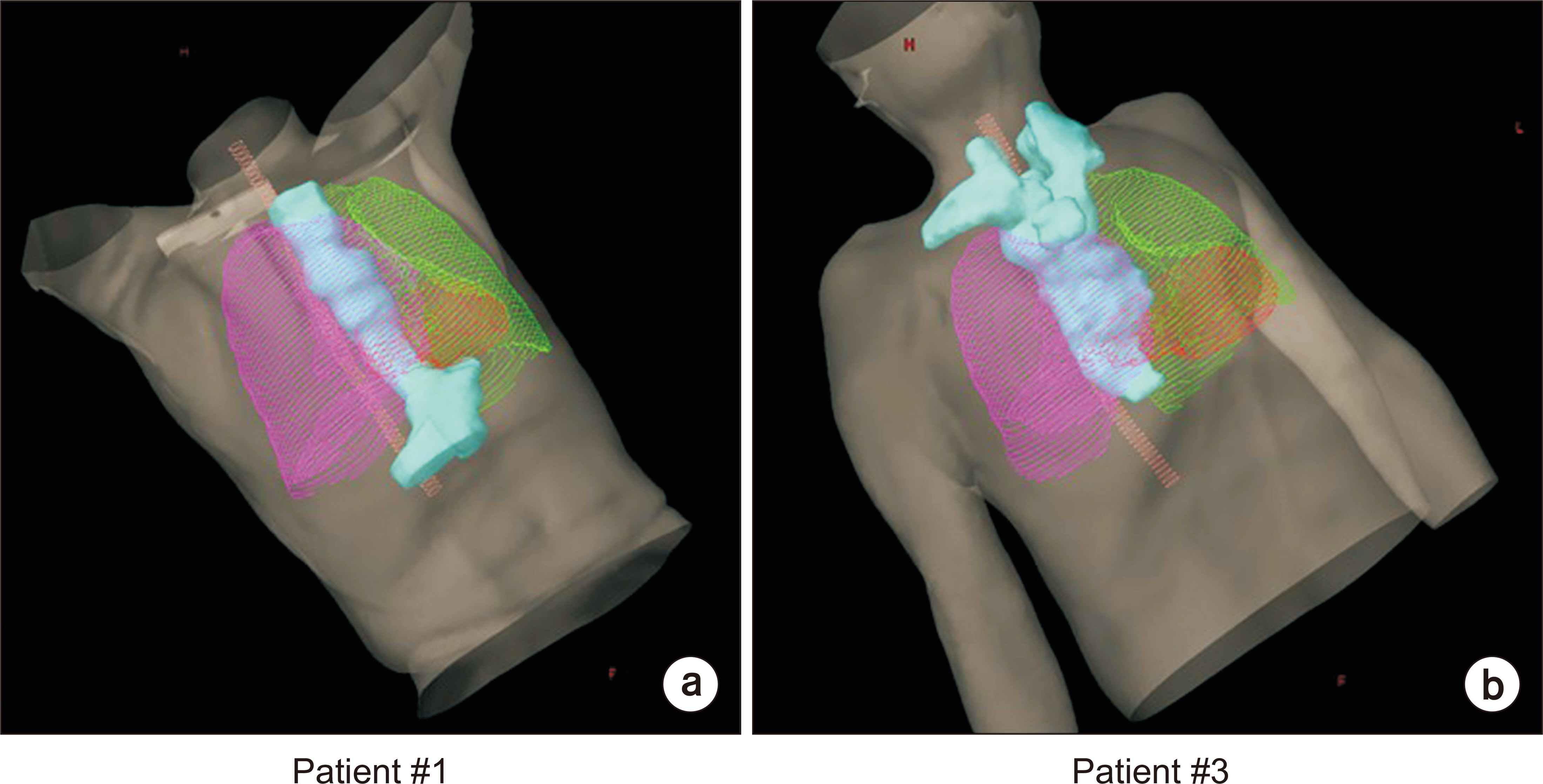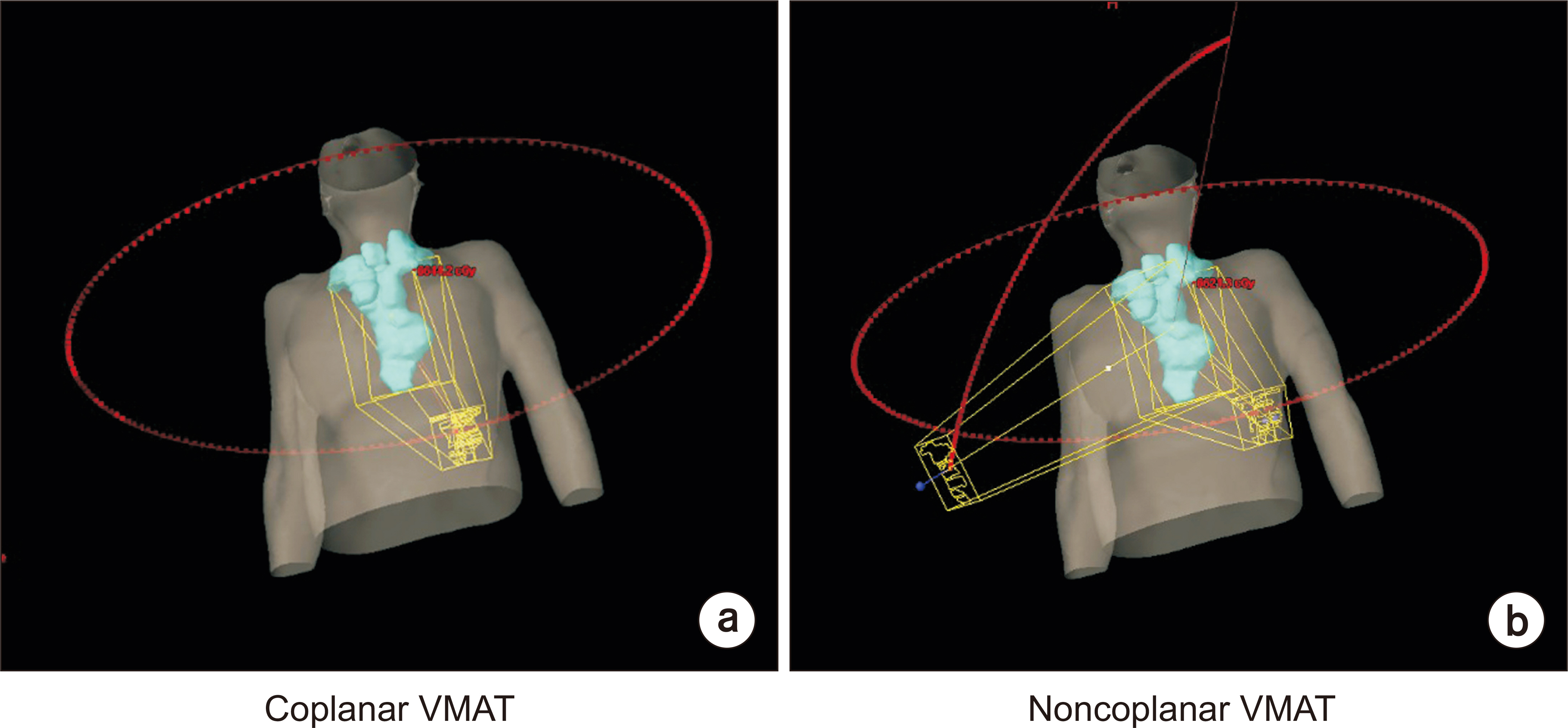Prog Med Phys.
2020 Dec;31(4):179-188. 10.14316/pmp.2020.31.4.179.
Dosimetric Comparison of Noncoplanar and Coplanar Volumetric Modulated Arc Therapy Plans for Esophageal Cancer
- Affiliations
-
- 1Department of Radiation Oncology, Veterans Health Service Medical Center, Seoul, Korea
- KMID: 2510479
- DOI: http://doi.org/10.14316/pmp.2020.31.4.179
Abstract
- Purpose
We compared noncoplanar volumetric modulated arc therapy (ncVMAT) plans to coplanar VMAT (cVMAT) plans by evaluating the dosimetric quality of each for esophageal cancer.
Methods
Twenty patients treated for esophageal cancer with the cVMAT technique were retrospectively selected. The cVMAT plans consisted of three coplanar full arc beams. The ncVMAT plans consisted of two coplanar full arc beams and one noncoplanar partial arc beam ranging from 45° to 315° with a couch rotation angle of 315°±5°. For dosimetric evaluation, the dose-volumetric (DV) parameters of the planning target volume (PTV) and organs at risk (OARs) were calculated for all VMAT plans.
Results
No clinically noticeable differences between the cVMAT and ncVMAT plans were observed in the DV parameters of the PTV. For the lungs, the V 13 Gy and mean dose for ncVMAT plans were smaller than those for cVMAT plans, showing statistically significant differences. For the heart, the values of the maximum dose for cVMAT and ncVMAT plans were 53.8±2.9 and 50.9±3.3 Gy, respectively (p=0.004). For the spinal cord, the values of the maximum dose for cVMAT and ncVMAT plans were 37.1±5.1 and 34.7±5.7 Gy, respectively (p<0.001).
Conclusions
The use of ncVMAT plans provides better PTV coverage and sparing of OARs compared to that of cVMAT plans for long, tube-like esophageal cancer. For esophageal cancer, the ncVMAT plans showed a more favorable plan quality than the cVMAT plans.
Figure
Reference
-
References
1. Statistics Korea. Statistics Korea. Statistics Korea 2020;Available from: http://www.index.go.kr/. cited 2020 Jan 16.2. Fawaz ZS, Kazandjian S, Tsui JM, Devic DS, Lecavalier-Barsoum M, Vuong T, et al. 2018; What is the optimal radiation technique for esophageal cancer? A dosimetric comparison of four techniques. Cureus. 10:e2985. DOI: 10.7759/cureus.2985. PMID: 30237946. PMCID: PMC6141055.
Article3. Zhang M, Wu AJ. 2017; Radiation techniques for esophageal cancer. Chin Clin Oncol. 6:45. DOI: 10.21037/cco.2017.06.33. PMID: 29129085.
Article4. Park J, Yea JW. 2019; Whole brain radiotherapy using four-field box technique with tilting baseplate for parotid gland sparing. Radiat Oncol J. 37:22–29. DOI: 10.3857/roj.2019.00059. PMID: 30947477. PMCID: PMC6453806.
Article5. Ahn YC. 2019; Less is more: role of additional chemotherapy to concurrent chemoradiotherapy in locoregionally advanced nasopharyngeal cancer management. Radiat Oncol J. 37:67–72. DOI: 10.3857/roj.2019.00311. PMID: 31266287. PMCID: PMC6610008.
Article6. Huh SJ, Park W, Choi DH. 2019; Recent trends in intensity-modulated radiation therapy use in Korea. Radiat Oncol J. 37:249–253. DOI: 10.3857/roj.2019.00577. PMID: 31918461. PMCID: PMC6952714.
Article7. Jeong C, Park JW, Kwak J, Song SY, Cho B. 2019; Volumetric-modulated arc radiotherapy using knowledge-based planning: application to spine stereotactic body radiotherapy. Prog Med Phys. 30:94–103.
Article8. Rahman MM, Kim CH, Kim S. 2019; Mid-term performance of clinical LINAC in volumetric modulated arc therapy. J Radiat Prot Res. 44:43–52.
Article9. Mayo CS, Urie MM, Fitzgerald TJ, Ding L, Lo YC, Bogdanov M. 2008; Hybrid IMRT for treatment of cancers of the lung and esophagus. Int J Radiat Oncol Biol Phys. 71:1408–1418. DOI: 10.1016/j.ijrobp.2007.12.008. PMID: 18262730.
Article10. Zhang WZ, Zhai TT, Lu JY, Chen JZ, Chen ZJ, Li DR, et al. 2015; Volumetric modulated arc therapy vs. c-IMRT for the treatment of upper thoracic esophageal cancer. PLoS One. 10:e0121385. DOI: 10.1371/journal.pone.0121385. PMID: 25815477. PMCID: PMC4376741.
Article11. Yin L, Wu H, Gong J, Geng JH, Jiang F, Shi AH, et al. 2012; Volumetric-modulated arc therapy vs. c-IMRT in esophageal cancer: a treatment planning comparison. World J Gastroenterol. 18:5266–5275. DOI: 10.3748/wjg.v18.i37.5266. PMID: 23066322. PMCID: PMC3468860.12. Xu C, Xi M, Komaki R, Balter PA, Huang M, Hobbs BP, et al. 2017; Dosimetric and clinical outcomes after volumetric modulated arc therapy for carcinoma of the thoracic esophagus. Adv Radiat Oncol. 2:325–332. DOI: 10.1016/j.adro.2017.03.006. PMID: 29114599. PMCID: PMC5605280.
Article13. Chan OS, Lee MC, Hung AW, Chang AT, Yeung RM, Lee AW. 2011; The superiority of hybrid-volumetric arc therapy (VMAT) technique over double arcs VMAT and 3D-conformal technique in the treatment of locally advanced non-small cell lung cancer--a planning study. Radiother Oncol. 101:298–302. DOI: 10.1016/j.radonc.2011.08.015. PMID: 21907438.14. Verbakel WF, van Reij E, Ladenius-Lischer I, Cuijpers JP, Slotman BJ, Senan S. 2012; Clinical application of a novel hybrid intensity-modulated radiotherapy technique for stage III lung cancer and dosimetric comparison with four other techniques. Int J Radiat Oncol Biol Phys. 83:e297–e303. DOI: 10.1016/j.ijrobp.2011.12.059. PMID: 22579380.15. Abbas AS, Moseley D, Kassam Z, Kim SM, Cho C. 2013; Volumetric-modulated arc therapy for the treatment of a large planning target volume in thoracic esophageal cancer. J Appl Clin Med Phys. 14:4269. DOI: 10.1120/jacmp.v14i3.4269. PMID: 23652258. PMCID: PMC5714417.
Article16. Li Y, Liu B, Zhai F, Yang Y, Liu M, Bao C, et al. 2013; Dosimetric study of coplanar and non-coplanar intensity-modulated radiation therapy planning for esophageal carcinoma. Int J Med Phys Clin Eng Radiat Oncol. 2:133–138.
Article17. Martini S, Arcadipane F, Strignano P, Spadi R, Contu V, Fiandra C, et al. 2018; Volumetric modulated arc therapy (VMAT) in the treatment of esophageal cancer patients. Med Oncol. 35:150. DOI: 10.1007/s12032-018-1211-7. PMID: 30284647.
Article18. Shaw E, Kline R, Gillin M, Souhami L, Hirschfeld A, Dinapoli R, et al. 1993; Radiation Therapy Oncology Group: radiosurgery quality assurance guidelines. Int J Radiat Oncol Biol Phys. 27:1231–1239. DOI: 10.1016/0360-3016(93)90548-a. PMID: 8262852.
Article19. Zhang P, Happersett L, Hunt M, Jackson A, Zelefsky M, Mageras G. 2010; Volumetric modulated arc therapy: planning and evaluation for prostate cancer cases. Int J Radiat Oncol Biol Phys. 76:1456–1462. DOI: 10.1016/j.ijrobp.2009.03.033. PMID: 19540062.
Article20. Kim ST, An HJ, Kim JI, Yoo JR, Kim HJ, Park JM. 2020; Non-coplanar VMAT plans for lung SABR to reduce dose to the heart: a planning study. Br J Radiol. 93:20190596. DOI: 10.1259/bjr.20190596. PMID: 31625759. PMCID: PMC6948076.
Article21. Paddick I, Lippitz B. 2006; A simple dose gradient measurement tool to complement the conformity index. J Neurosurg. 105 Suppl:194–201. DOI: 10.3171/sup.2006.105.7.194. PMID: 18503356.
Article22. Woods K, Nguyen D, Tran A, Yu VY, Cao M, Niu T, et al. 2016; Viability of non-coplanar VMAT for liver SBRT as compared to coplanar VMAT and beam orientation optimized 4π IMRT. Adv Radiat Oncol. 1:67–75. DOI: 10.1016/j.adro.2015.12.004. PMID: 27104216. PMCID: PMC4834900.23. Wild E, Bangert M, Nill S, Oelfke U. 2015; Noncoplanar VMAT for nasopharyngeal tumors: plan quality versus treatment time. Med Phys. 42:2157–2168. DOI: 10.1118/1.4914863. PMID: 25979010.
Article24. Dong P, Lee P, Ruan D, Long T, Romeijn E, Low DA, et al. 2013; 4π noncoplanar stereotactic body radiation therapy for centrally located or larger lung tumors. Int J Radiat Oncol Biol Phys. 86:407–413. DOI: 10.1016/j.ijrobp.2013.02.002. PMID: 23523322.
Article25. Zhang S, Yang R, Shi C, Li J, Zhuang H, Tian S, et al. 2019; Noncoplanar VMAT for brain metastases: a plan quality and delivery efficiency comparison with coplanar VMAT, IMRT, and CyberKnife. Technol Cancer Res Treat. 18:1533033819871621. DOI: 10.1177/1533033819871621. PMID: 31451059. PMCID: PMC6710677.
Article26. Smyth G, Evans PM, Bamber JC, Mandeville HC, Welsh LC, Saran FH, et al. 2016; Non-coplanar trajectories to improve organ at risk sparing in volumetric modulated arc therapy for primary brain tumors. Radiother Oncol. 121:124–131. DOI: 10.1016/j.radonc.2016.07.014. PMID: 27481571.
Article27. Sharfo AW, Dirkx ML, Breedveld S, Méndez Romero A, Heijmen BJ. 2017; VMAT plus a few computer-optimized non-coplanar IMRT beams (VMAT+) tested for liver SBRT. Radiother Oncol. 123:49–56. DOI: 10.1016/j.radonc.2017.02.018. PMID: 28341061.
Article28. Gayen S, Kombathula SH, Manna S, Varshney S, Pareek P. 2020; Dosimetric comparison of coplanar and non-coplanar volumetric-modulated arc therapy in head and neck cancer treated with radiotherapy. Radiat Oncol J. 38:138–147. DOI: 10.3857/roj.2020.00143. PMID: 33012157. PMCID: PMC7533406.
Article
- Full Text Links
- Actions
-
Cited
- CITED
-
- Close
- Share
- Similar articles
-
- Dosimetric comparison of coplanar and non-coplanar volumetric-modulated arc therapy in head and neck cancer treated with radiotherapy
- Dosimetric comparison of intensity-modulated radiotherapy (IMRT) and volumetric modulated arc therapy (VMAT) in total scalp irradiation: a single institutional experience
- Dosimetric comparison between modulated arc therapy and static intensity modulated radiotherapy in thoracic esophageal cancer: a single institutional experience
- A Dosimetric Comparision of IMRT and VMAT in Synchronous Bilateral Breast Cancer
- Dosimetric comparison of volumetric modulated arc therapy with robotic stereotactic radiation therapy in hepatocellular carcinoma





